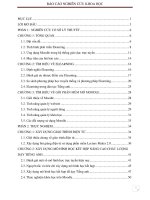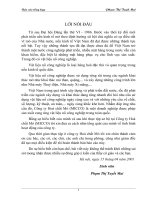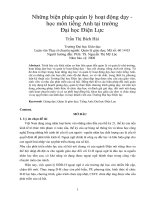Nghiên cứu những thuận lợi và trở ngại trong lớp học của việc dạy và học nói tiếng anh tại trường đại học phương đông
Bạn đang xem bản rút gọn của tài liệu. Xem và tải ngay bản đầy đủ của tài liệu tại đây (187.56 KB, 12 trang )
VIETNAM NATIONAL UNIVERSITY, HANOI
UNIVERSITY OF LANGUAGES AND INTERNATIONAL STUDIES
FACULTY OF POSTGRADUATE STUDIES
----------o0o----------
NGUYỄN THỊ NGA
AN INVESTIGATION INTO CLASSROOM OPPORTUNITIES FOR AND
CONSTRAINTS ON THE TEACHING AND LEARNING OF ENGLISH
SPEAKING SKILLS AT PHUONG DONG UNIVERSITY
Nghiên cứu những thuận lợi và trở ngại trong lớp học của việc dạy và học nói
tiếng Anh tại trường Đại học Phương Đông
M.A. MINOR PROGRAM THESIS
FIELD: ENGLISH TEACHING METHODOLOGY
CODE: 60140111
Hanoi, 2015
VIETNAM NATIONAL UNIVERSITY, HANOI
UNIVERSITY OF LANGUAGES AND INTERNATIONAL STUDIES
FACULTY OF POSTGRADUATE STUDIES
----------o0o----------
NGUYỄN THỊ NGA
AN INVESTIGATION INTO CLASSROOM OPPORTUNITIES FOR AND
CONSTRAINTS ON THE TEACHING AND LEARNING OF ENGLISH
SPEAKING SKILLS AT PHUONG DONG UNIVERSITY
Nghiên cứu những thuận lợi và trở ngại trong lớp học của việc dạy và học nói
tiếng Anh tại trường Đại học Phương Đông
M.A. MINOR PROGRAM THESIS
FIELD: ENGLISH TEACHING METHODOLOGY
CODE: 60140111
SUPERVISOR: Assoc. Prof. Le Van Canh, PhD
Hanoi, 2015
DECLARATION
I, Nguyễn Thị Nga, K22 being a candidate for the degree of Master of Arts hereby
certify that this minor thesis entitled AN INVESTIGATION INTO CLASSROOM
OPPORTUNITIES FOR AND CONSTRAINTS ON THE TEACHING AND LEARNING OF
ENGLISH SPEAKING SKILLS AT
PHUONG DONG UNIVERSITY
is completely the result of my own work for the Degree of
Master at University of Languages and International Studies, Vietnam National
University, Hanoi and that this thesis has not been submitted for any degree at any other
university or institution.
Hanoi, December 8th , 2015
Candidate
Nguyễn Thị Nga
1
ACKNOWLEDGEMENTS
This thesis could not have been completed without the help, encouragement
and support of a number of people who all deserve my sincerest gratitude and
appreciation.
First and foremost, I would like to express my deepest gratitude to my
supervisor, Assoc. Prof Le Van Canh, Ph.D for his continuous support, his
patience, motivation and immense knowledge. His guidance helped me in all the
time of research and writing of this thesis. I could not have imagined having a
better supervisor for my thesis.
Secondly, I would like to send my thanks to all lectures and the staff of the
Faculty of Post Graduate Studies at University of Languages and International
Studies of Vietnam National University Hanoi for their useful materials,
instructions and enthusiasm which are of great importance to this thesis.
My special thanks also go to my colleagues and students of Phuong Dong
University whose valuable advice, tremendous assistance and cooperation are
indispensable for the thesis. Without their help, this study could not have been
fulfilled.
I find myself indebt to my beloved family- my parents, my husband, my
sisters and brothers and all my friends who have always stood for me with their
consideration and encouragements to help me overcome all problems to complete
this thesis.
Last but not least, I would like to send my special thanks to my readers for
their concern, interest and comments for this study.
2
ABSTRACT
This thesis aims at investigating the classroom opportunities for and
constraints on the teaching and learning of speaking skills of non-major students
at Phuong Dong University. Specifically, the study has been conducted in the
form of a survey research with three instruments: the classroom observation, the
questionnaire and the interview. The participants are 70 non-major students and
3English teachers from Phuong Dong University. The data revealed that students
of Phuong Dong University experience certain opportunities as well as
difficulties from themselves and from their teachers when taking part in speaking
activities and techniques given by their teachers during speaking lessons. Some
recommendations to overcome the difficulties are also given in the thesis.
It is hoped that this thesis will be useful for both teachers and students of
Phuong Dong University in their teaching and learning of English speaking
skills.
3
LIST OF TABLES
Table 1: Students’ English learning history
Table 2: Students’ general opinions on language skills
Table 3: Students’ opinions on speaking skill
Table 4: Students’ assessment of their speaking skills
Table 5: Students’ assessment of speaking activities in speaking lessons
Table 6: Students’ participation in speaking class
Table 7: Tteachers’’ instructions in speaking class
Table 8: Teachers’ mistake correction
Table 9: Students’ opportunities in speaking activities during speaking lessons
Table 10: Students’ difficulties in speaking activities during speaking lessons
4
PART I: INTRODUCTION
1. Rationale
Amid the context of international integration and globalization, English has
become an international language and increasingly proved its important role in
all fields of life, including education. In recent years, Vietnam has eye-witnessed
an upward trend of teaching and learning English, especially when students are
fully aware of educational opportunities that they can benefit from the mastery of
English.
In Vietnam, English is taught as a foreign language that has four skills,
namely listening, reading, speaking and writing. Among these four skills,
speaking seems to be the most demanding but central skill. However, students
have experienced lots of problems during their speaking learning. Despite the
fact that some students who have learnt the English language for more than ten
years, they are unable to use the language fluently and effectively. They are often
passive and shy in using English in real communication. The reasons behind this
problem are various. Some students say that they don’t know what to say or
afraid of making mistakes. Others claim that lack of ideas, vocabulary or stimuli
are factors inhabiting them from participating in speaking tasks. The teachers of
English are also to blame in this situation. They may not have provided enough
opportunities to students for improving their communication skills. Besides, they
may not have properly used classroom techniques or strategies in developing
English for communication. Therefore, all these factors have made the process of
teaching and learning speaking skills become irrelevant, boring and sometimes a
burden, too.
With 3 years of experience in teaching English at Phuong Dong University, I
realized that during the process of teaching and learning speaking skill, both
teachers and non-major students at my own university have experienced not only
opportunities but constraints as well. Actually, being aware of this current
situation, in some ways, will enable the people involved to continue to benefit
from the advantages and try to identify and suggest practical solutions to the
problems they have to encounter. This awareness will also pay the way for the
5
improvement of teaching and learning English in order to ensure a better future
of using English as a communicative language for non-major students at Phuong
Dong University. Therefore, all these aforementioned factors have encouraged
me to undertake a survey research in which I would like to identify the
opportunities as well as constraints in classrooms of teachers and students when
dealing with English speaking skill at my own university. I am inspired to
conduct a study named “An investigation into classroom opportunities for and
constraints on the teaching and learning of English speaking skills at Phuong
Dong University”.
2. Aims and objectives of the study
The study is certainly aimed at finding out the opportunities as well as
constraints in classroom which teachers and non-major students of Phuong Dong
University have to experience during the process of teaching and learning
English speaking skills. Specifically, the objectives of the research are as
follows:
(1) To investigate the common classroom activities and techniques in
teaching speaking skills to non-major students at Phuong Dong
University.
(2) To explore the learning opportunities that those activities create for
students to develop their speaking skills.
(3) To find out the constraints on speaking skills of students brought about by
those activities.
3. Research methodology
Three research questions will be addressed as follows:
(1)What are the teachers’ common classroom activities and techniques in
teaching English speaking skill to non-major students at Phuong Dong
University?
(2) What learning opportunities do those classroom activities and techniques
create for non-major students to develop their speaking skills?
(3) To what extent do those classroom activities and techniques constrain on
non-major students’ speaking skills?
6
In order to answer the research questions stated above, this study is carried out
on the combination of two different methods, namely quantitative and qualitative
methods.
As for instrument, classroom observation is carried out to find out teachers’
common classroom practices in speaking lessons. Survey questionnaires for
students and interviews with both teachers and students are carried out to find out
the opportunities and constraints of those practices they have to experience
during speaking lessons.
As for participants, the study is intended to involve 70 second-year students of
Phuong Dong University. They come from 3 classes of Finance and Banking
Department and now are in the first semester of their second year, working with
Starting Skill 2. Moreover, 3 teachers who are directly responsible of teaching
English speaking skill for the 3 classes at Phuong Dong University also take part
in the study.
4. Scope of the study
This study only focuses on the classroom opportunities and constraints on the
teaching and learning of English speaking skills at Phuong Dong University.
However, in an attempt to make this study more manageable, the study only aims
at the teaching and learning of English speaking skills of non-major students at
Phuong Dong University. The subjects of the study are restricted to 70 secondyear students at Phuong Dong University despite their gender and ability and 3
English teachers who directly teach speaking skill for non-major students of
Phuong Dong University.
5. Structure of the thesis
The study is divided into three main parts, and a list of reference and
appendices are attached to the end
Part I, Introduction, presents the rationale, the aims and objectives, the scope, the
research methods and the design of the study
Part II, Development, consists of three chapters. Chapter one is the Literature
review. This chapter provides the theoretical background of the study. Chapter
two is the Methodology of the study which includes instruments, participants,
7
REFERENCES
1. Allwright, D & K.M. Bailey. (1991). Focus on the Language Classroom:
An Introduction to Classroom Research for Language Teachers.
Cambridge University Press
2. Angelo, T.A. (1993). A Teacher’s Dozen : Fourteen General, Researchbased Principles for Improving Higher Learning in Our Classroom. The
Modern Language Journal
3. Brown, H.D. (1994). Teaching by Principle: An Interactive Approach to
Language Pedagogy. Eaglewood Cliffs, N.J: Prentice Hall.
4. Brown. G & Yule, G. (1983). Teaching the Spoken Language. Cambridge
Language Teaching Library.
5. Bygate, M. (1987). Speaking. Oxford University Press.
6. Byrme, D. (1991). Focus On The Classroom. Hongkong: Modern English
Publications.
7. Canale, M & Swain, M. (1980). Approaches to Communicative
Competence. Singapore RELC.
8. Cazden, C.B. (1988). Classroom Discourse: The Language of Teaching
and Learning. Portsmouth, NH:Heinemann
9. Doff, A. (1988). Teaching English: A training course for teachers.
Cambridge University Press.
10. Ellis, R. (1997). Second Language Acquisition. Cambridge University
Press.
11. Gardner, R & Lambert, W. (1972). Attitudes and Motivation in Second
Language Learning. New York : Newsbury House.
12. Gillies, R.M. (2006). Teacher’s and Students’ Verbal Behaviors during
Cooperative and Small-group Learning. British Journal of Educational
Psychology.
13. Hall, J,K, & Walsh, M. (2002). Teacher-student Interaction and Language
Learning. Annual Review of Applied Linguistic.
14. Harmer, J. (1991). The Practice of English Language Teaching. Longman.
15. Hymes, D.H. (1971). On Communicative Competence. In J.Pride and
J.Homes. Sociolinguistics. Penguin, 1972.
8
16. Krashen, S. (1985). The Input Hypothesis: Issues and Implications.
London: Longman.
17. Le Van Canh. (2004). Understanding Foreign Language Teaching
Methodology. National University Publishing House.
18. Lewis, M & Hill, J. (1992). Practical Techniques for Language Teaching.
Commercial Colour Press.
19. Lighbow, P.M & Spada, N. (1999). How Languages are Learned. Oxford
University Press.
20. Littlewood, W. (1981). Communicative Language Teaching. Cambridge
University Press.
21. Long, M. (1980). Input, Interaction, and Second language acquisition.
Unpublished Doctoral Dissertation. Los Angeles : University of
California.
22. Long, M. (1989). Task, group, and task-group interactions. University of
Hawaii Working Papers in ESL
23. Nunan, D. (1989). Designing Tasks for the Communicative Classroom.
Cambridge University Press.
24. Nunan, D. (1991). Language Teaching Methodology. London : Phoenix
ELT.
25. Phillips, T & Phillips, A & Gough, C. (2010). Starting skills 2. Garnet
Publishing Ltd.
26. Richards, J.C. (1983). Communicative Needs in Foreign Language
Learning. ELT Journal. V37.1983.
27. Richards, J. & T. Rogers. (1986). Approaches and Methods in language
teaching. Cambridge University Press
28. Ur, P. (1981). Discussion that work: Task-centered Fleecy Practice.
Cambridge University Press.
29. Ur, P. (1996). A Course in Language Teaching. Cambridge University
Press.
30. Van Lier, L. (1996). Interaction in the Language Curriculum: Awareness,
Autonomy and Authenticity. Harlow, England : Addison Wesley Longman
Limited.
9
I









